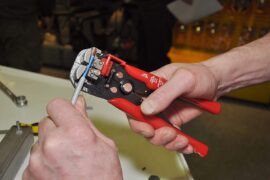The world is full of interesting things to explore and oftentimes, we wish we could see them a little bit closer. Good thing you could have that clearer view with a very simple tool that could be carried wherever you go. A pocket microscope is a nice tool that could make your or your kids’ exploration more fun and exciting.
A pocket microscope could also make your job a lot easier, especially if it entails inspection of industrial materials for corrosion or rocks for minerals or circuit boards. The same thing goes for parents doing homeschooling. Imagine giving your kid the freedom to enjoy learning in the field, untied from a table-top microscope.
Adults or kids would have a great time at work or play with this tool. You won’t want to end up with junk, though. That is why we have summarized in this article the topic options that you might want to consider in your purchase. These are the top pocket microscopes that were tried and tested.
Best Pocket Microscopes Comparison & Rating
Pocket Microscopes | Features |
1. YINAMA 50X-1000X Wireless Digital Pocket Microscopes
Imagine high power magnification in your pocket? Imagine no more. YINAMA offers a wireless digital pocket microscope that does not only offer high magnification. It also designed ways to resolve some of the issues you might have experienced with your previous pocket microscopes. First, it comes with a stand so that focusing would not drive your hands to exhaustion trying to steady the tool while trying to get a good focus. Further, while looking at the subjects from the eyepiece might be quite fun and exciting, it tends to become straining on the eyes after some time. This product offers an easy solution through the projection of the magnified image through the screens of your phone or laptop. It also makes it easier to capture the subject in image or video formats. Whether you are trying to inspect skin, plant, jewelry, or industrial materials, this is one investment you would never regret. The fact that it is easy to set up is the icing on the cake.
2. T TAKMLY 50X-1000X Wireless Handheld Digital Microscope
For high digital magnification, another option that you could consider is T TAKMLY Wireless digital handheld microscope which offers 50x to 1000x magnification. It is nice that the image could be viewed through your phone so you could easily use this to inspect circuit boards. This would also be really nice for classroom explorations. Imagine that unlike your traditional microscope where kids need to take turns viewing the specimen, everyone could share the fun of exploring with this digital pocket microscope because the magnified image could be shared by everyone. The images are also clear. That you don’t need to replace batteries because it is built-in with a rechargeable one is a nice bonus.
3. Carson MicroFlip 100X-250X LED/UV-Lighted Pocket Microscope
Carson is a name you should probably remember when you are on the loo-out for a durable, lightweight, and powerful pocket microscope. For a very reasonable price, you could have 250x magnification in your pocket. True, using it takes some getting used to, especially the focusing of your subject. Once you get the hang of it though, it is truly amazing. The picture quality is top quality whether you are inspecting minerals on rock samples, inspecting orchid seeds, or other organisms. Aside from the high magnification, what I also like about this tool is the flexibility. With just a flip of the slide base, you could either have a microscope with a base for the slide or a field microscope that could be readily directed to investigate flat surfaces. Further, while it is more fun looking at things through the eyepiece, in case your eyes are strained you could simply view the images from your smartphone, by using the clip, You could even capture the magnified images through pictures or videos for recording or comparison eventually. Whether you’re purchasing it for exploration or for pure entertainment, it is worth your money.
4. Carson MicroBrite Plus 60X-120X LED-Lighted Zoom Pocket Microscope
You will be surprised that this pocket microscope which costs like a toy is really not a toy. It is interesting how these products could be solid, lightweight, and powerful all at the same time. It worked well looking at the casing of the praying mantis or checking the readiness of herbs. It also worked well in inspecting solder joints and corrosion on metals, among others. It is best for viewing prepared slides, and other stationary and flat objects. It is true that using it requires some tinkering and getting used to, especially for three-dimensional and moving organisms. Once you get the hang of it, though, it could deliver great results whether it be in sunlight or dark. The image quality is quite good. I also appreciate the very nice design of the microscope which makes it a lot easier to use. It is also a nice bonus that the LED light remains on without having to keep your hand on the power button. This surely would make the world a much more interesting place to investigate for kids and adults alike.
5. SE MW10084 30X LED-Illuminated Pocket Microscope
Looking for a pocket microscope at the cost of your 20-piece spicy nugget meal? You might want to check out SE LED-Illuminated Pocket Microscope which offers 30x magnification which is ideal for everyday uses or fun exploration. This could be a handy tool to check out gemstones, jewels, coins, and stamps. You could even use it for splinter removal. The most interesting feature of this microscope is the 45-degree adjustability of the LED light for better angling and lighting. Kids and adults alike are going to have a lot of fun toying with this tool, though it is more than a toy.
Best Pocket Microscopes - Buyer's Guide
If you are buying a pocket microscope, you are surely concerned about magnification. However, how much magnification should you be looking for would depend on the subjects you are planning to use them on. While higher magnification is nice, it might also provide certain limitations when the minimum magnification your microscope offers is simply too strong for the task at hand.
Focusing is an important part of using your microscope. A great illumination would come in handy to come up with better views of your subject so you might want to check them out as well. If this illumination is adjustable, then that is even better.
There are some things to fiddle before you get a nice view of your subjects such as the focus and zoom. Hence, it would be ideal to check the design of the control knobs. It would be best if they are smooth functioning. That way, they would not disrupt your angle with the slightest adjustment.
It is not enough that a pocket microscope offers high magnification. It is also important how that magnified image would be viewed. You should probably check out for the clarity of the image. This is important whether you use it for tasks that require accuracy or for pure fun.
A tool that is difficult to use is no fun at all. Hence, you might need to check out for pocket microscopes with more ergonomic designs for better gripping or the inclusion of accessories to save you from the strain of maintaining a steady hand while trying to focus. You should also check the product design to see if the functions and controls are positioned for ease of use. For a digital microscope, the ease of installation and use would also be nice to consider.
Best Pocket Microscopes - FAQs
A pocket microscope is a portable tool that could be used for a wide range of tasks requiring magnification both indoors and outdoors. It is small and lightweight which could usually be fitted into your pockets. These could be built with slides for inspection or could be used for field inspection or exploration. Depending on the level of magnification it offers, it could be used to view currencies, organisms, and many more.
Digital pocket microscopes provide magnification just like a typical pocket microscope. However, the magnified image could be viewed through a digital device connected to the scope such as phones, tablets, or laptops. This is very useful in capturing images or videos of the object being viewed.
The image appears dimmer in the microscope with higher magnification because it has lower light intensity. When you use a scope with higher magnification, you are looking at a smaller area. Remember that there is a fixed amount of light per area so if you are looking at a smaller space, you are seeing less light as well. This is why your view is dimmer.
Lower magnification will give you a wider view. By starting from this point, you could easily locate what you are looking for and gradually increase the magnification.











